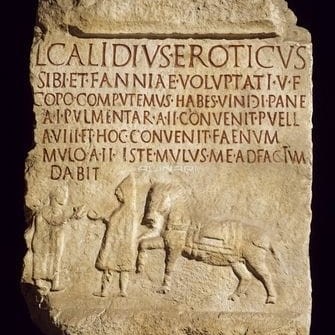Translated from french (please notify us of errors)

Pliny the Elder, in the 1st century, didn’t mince his words: for him, curdled milk was a barbarian affair. One can picture it: nomadic horsemen traversing the steppes with sheepskin bags of sheep’s milk attached to their saddles, fermenting under the jolting… He marvelled:
“It is surprising that barbarous nations, who live on milk, have either not known for so many ages, or else have rejected, the use of cheese; they generally, however, thicken milk and form therefrom an acrid kind of liquid with a pleasant flavour, as also a rich butter”1
The Roman encyclopaedist was in fact following an ancient Greco-Roman tradition, according to which the consumption of olive oil and cheese marks a superior state of civilisation, with barbarians having to make do with curdled milk and butter. In the 4th century BCE, the Greek comic poet Anaxandrides mocked the Thracians by calling them “butter-eaters”.
Milk-drinkers versus cheese-eaters
In reality, cheese or not, fermented milk (sour milk, curdled milk or even turned milk depending on the process—and later yoghurt) has been attested as a food product for millennia amongst all ancient peoples, from the time of the domestication of milk-producing animals: cows, and especially sheep and goats.
Eight centuries before our era, Homer relates in the Odyssey that the Cyclops, having milked his goats and ewes, “curdled one half of the white milk and gathered it and placed it in wicker baskets, and the other half he set in pails, that he might have it to drink and that it might serve him for supper”2.
And 2,500 years ago, the Greek historian and geographer Herodotus describes a technique of the Scythians, consisting in “stirring and shaking” milk in wooden vessels to separate the butter from the buttermilk.
Romans though they were, Pliny’s contemporaries certainly did not disdain fermented milk. Indeed, two Latin words designate these dairy preparations, which turn out to be two names for the same type of product3.
Oxygala first, borrowed from the Greek ὀξύγαλα (from ὀξύς, sour, and γάλα, milk). Pliny the Elder describes the simplest process: after churning milk slightly diluted with water in tall vessels with narrow openings, one recovers the curd that rises to the surface. “What is taken from it, after adding salt, they call oxygala”, he explains4. The remainder, once boiled, produces butter. But Pliny catalogues these products chiefly amongst remedies, specifying that “its nature is to be astringent, emollient, incarnative, purgative”. Beyond this basic recipe—which allowed fresh milk to be inoculated to make it turn sour, then to constantly renew the preparation—Columella proposes a far more sophisticated gastronomic version: ten days of maturing with successive draining of whey, maceration of fresh herbs (oregano, mint, onion, coriander), then final seasoning with thyme, savory and chopped leek5. A veritable preserve of soured milk with herbs, far removed from simple curds.
When Rome chilled its melca with snow
The other term, melca—perhaps related to the Latin mulgere, “to milk”—designates the same type of preparation. The physician Galen, in the 2nd century, confirms that melca counts amongst “the dishes enjoying a good reputation in Rome”. He prescribes it to his patients suffering from excessive heat or gastric atony, always served very cold, chilled with snow according to Roman practice6. Far from being a simple remedy, this fermented milk had conquered the tables of the capital, consumed alongside other dairy delicacies such as aphrogala (frothy milk). Apicius, for his part, proposes a recipe for a dessert of curdled milk. Without suspecting that it would offend our modern taste, he seasons it with pepper and garum, or more soberly with salt, oil and coriander7.
But fortunately for us, it is more than likely that these fermented milks were also accompanied with honey and nuts, according to a tradition that has continued to this day in Greece.
1 Pliny the Elder, Historia Naturalis, Liber 11, 96 (239): Mirum barbaras gentes, quae lacte vivant, ignorare aut spernere tot saeculis casei dotem, densantes id alioqui in acorem iucundum et pingue butyrum.
2 Hómēros, Odýsseia, 9, 245-248: Αὐτίκα δ᾽ἥμισυ μὲν θρέψας λευκοῖο γάλακτος πλεκτοῖς ἐν ταλάροισιν ἀμησάμενος κατέθηκεν, ἥμισυ δ᾽αὖτ᾽ἔστησεν ἐν ἄγγεσιν ὄφρα οἱ εἴη πίνειν αἰνυμένῳ καί οἱ ποτιδόρπιον εἴη.
3 The equivalence between the two terms is confirmed by Anthimus (6th century), De observatione ciborum, 78: oxygala, quod Latini uocant melcam, id est lac quod acetauerit. “oxygala, which the Latins call melca, that is to say milk that has turned sour”).
4 Pliny the Elder, Historia Naturalis, 28, 35 (133-134): E lacte fit et butyrum, barbararum gentium lautissimus cibus et qui divites a plebe discernat. […] sed hieme calefacto lacte, aestate expresso tantum, crebro iactatu in longis vasis angusto foramine spiritum accipientibus sub ipso ore alias praeligato. additur paulum aquae, ut acescat. quod est maxime coactum, in summo fluitat; id exemptum addito sale oxygala appellant. relicum decocunt in ollis; ibi quod supernatat, butyrum est, oleosum natura. […] natura eius adstringere, mollire, replere, purgare. “From milk is also made butter, the most delicate food among barbarous nations, and one which distinguishes the rich from the multitude. […] but in winter with warmed milk, in summer with milk merely drawn from the udder, by frequent shaking in tall vessels with a narrow opening that admits air, the mouth being otherwise closed. A little water is added so that it may turn sour. What is most thickened floats on the surface; this, when removed, with salt added, they call oxygala. The remainder they boil in pots; there what floats on top is butter, oily by nature. […] Its nature is to be astringent, emollient, incarnative, purgative.”
5 Columella, De re rustica, 12, 8, Oxygalae compositio: Oxygalam sic facito : ollam novam sumito eamque iuxta fundum terebrato ; deinde cavum, quem feceris, surculo obturato et lacte ovillo quam recentissimo vas repleto eoque adicito viridium condimentorum fasciculos origani, mentae, cepae, coriandri. Has herbas ita in lacte demittito, ut ligamina earum exstent. Post diem quintum surculum, quo cavum opturaveras, eximito et serum emittito ; cum deinde lac coeperit manare, eodem surculo cavum obturato, intermissoque triduo, ita ut supra dictum est, serum emittito et fasciculos condimentorum exemptos abicito, deinde exiguum aridi thymi et cunelae aridae super lac destringito concisique sectivi porri quantum videbitur adicito et permisceto ; mox intermisso biduo rursus emittito serum cavumque obturato et salis triti quantum satis erit adicito et misceto. Operculo deinde inposito oblinito. Non antea aperueris ollam, quam usus exegerit. “You shall make oxygala thus: take a new pot and bore it near the bottom; then stop up the hole you have made with a twig, and fill the vessel with sheep’s milk as fresh as possible, and add to it bunches of green seasonings: oregano, mint, onion, coriander. Immerse these herbs in the milk in such a way that their fastenings protrude. After the fifth day, remove the twig with which you had stopped up the hole and let out the whey; then, when the milk begins to flow, stop up the hole again with the same twig, and after leaving it for three days, as has been said above, let out the whey and remove the bunches of seasonings to discard them; then crumble over the milk a little dried thyme and dried cunila, and add chopped leek as much as seems good to you, and mix; soon, after leaving it for two days, let out the whey again and stop up the hole, add crushed salt in sufficient quantity and mix. Then, having placed the lid on, seal it. You shall not open the pot before use requires it.”
6 Galen, De sanitate tuenda (Hygieina), 6 (ed. Kühn, p. 811): ἐν οἷς ἐστι καὶ ἡ μέλκα, τῶν ἐν Ῥώμῃ καὶ τοῦτο ἓν εὐδοκιμούντων ἐδεσμάτων, ὥσπερ καὶ τὸ ἀφρόγαλα. “Amongst which is also melca, this too being one of the dishes enjoying a good reputation in Rome, just like aphrogala”; and 10 (ed. Kühn, p. 468): καθάπερ γε καὶ τῆς καλουμένης παρὰ Ῥωμαίοις μέλκης ἐψυχρισμένης, ἀφρογάλακτός τε καὶ τῶν διὰ γάλακτος ἐδεσμάτων. “likewise also the [preparation] called melca by the Romans, chilled, as well as aphrogala and dishes made from milk”.
7 Apicius, De re coquinaria, 7, 11: Melcas: cum piper et liquamen, vel sale, oleo et coriandro. “Melcas: with pepper and garum, or salt, oil and coriander.”).
Sources:
- L’alimentation et la cuisine à Rome, Jacques André, Les Belles Lettres, Paris (FR), 2018 (reprint), pp. 156-157.
- Ancient authors cited: Homer, Pliny the Elder, Columella, Galen, Apicius.
- Le fromage en Gaule à l’âge du Fer et à l’époque romaine: état des lieux pour sa production et analyse de sa place dans le monde antique, Alain Ferdière and Jean-Marc Séguier, 2020.
Version of 21.11.2025, first edition 29.1.2022
D’autres articles du blog de l’association Nunc est bibendum


